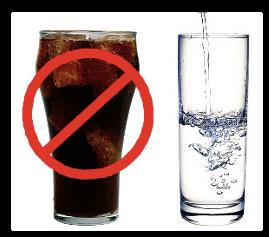Water: an essential element for life
By Razieh Fazrad, Graduate Student in Food Science and Technology, Virginia Tech, Water INTERface IGEP Program
Water is essential for life and normal functioning of the human body, however many of consumers are unaware of the nutritional values of this beverage and its role in promoting good health. This week in our water for health seminar class we explored the role of water in health such as the need of human body for water and role of water in weight management. It was an engaging conversation among graduate students from different majors related to the chemistry, microbiology, engineering and health aspects of drinking water. In this blog I reflected on our interdisciplinary points of view regarding role of water in health.
Our Daily Choices Of Beverages:
Do you know how much beverages you drink every day? What portion of calories in your diet is coming from beverages? There are some rapid and brief questionnaires to assess habitual beverage intake such as BEVQ form available for measuring daily beverage intake and their calories. We started the water health seminar class at September 13th with assessment of our daily beverages intake using BEVQ form and then we compared our results with USDA report on Beverage Choices of U.S. Adults. USDA report is based on National Health and Nutrition Examination Survey (NHANES). NHANES measures health beyond dietary habits in a specially designed and equipped mobile center, which travels to locations throughout the country. The Survey is unique because it combines interviews and physical examinations. According to USDA report, plain water, coffee and regular soft/other drinks have the largest percentage in adults over 20 in United States, overall beverages provide 18% of total calories and beverages provide high proportions of adult daily intakes of added sugars, vitamin C and D and calcium. In the class of only eight students there was an obvious diversity of drinking beverages choices. What are the factors that affect our daily choices of beverages? Every person has different habitual diets but in general age, gender, environmental, cultural and social factors affect our daily choices of beverages.
“Drink Lots of Water” is part of the mantra for weight management
How much easier is it to get calories in the form of beverages? Do you reduce your food intake to compensate for those calories coming from beverages? Unlike many people around the world who suffer from shortage of clean water most Americans have an unlimited supply of clean water to quench their thirsts. Yet many of us reach for other beverages throughout the day, like sodas, juices, coffee, and tea, despite warnings from health experts over recent years about the added calories in sweetened beverages and the health benefits of plain water. In the class we discussed a summarized review study on effect of drinking water on weight management (1). According to this review paper crossover experiments consistently reported that drinking water results in decreased total energy intake when consumed instead of caloric beverages and also results in greater fat oxidation compared with other beverages. Data is contrary in regards to diet drinks. Some research suggests that they can limit total energy intake like water however there are some research suggesting that Aspartame-sweetened drinks may increase food intake. There is lots of research going on that show unhealthy beverages patterns also dictate unhealthy dietary patterns.

What are the best beverages for health and how do we choose from so many options available?
To give some perspective for choosing beverages, the Beverage Guidance Panel drenched its recommendations into a pitcher (see the picture below, values that are shown below are recommendation from different panels that has been put in consensus). Data is based on a person taking 2,200 calories a day.

Importance of hydration
Water comprises from 75% body weight in infants to 55% in elderly and plays very crucial roles in the cellular hemostasis and life. It works as building block, as solvent, reaction medium, etc. Therefore the optimal functioning of our body requires a good hydration level. If we keep in mind that our body is made up of at least 50% water, we will want to make water our beverage of choice as often as we can. The vast majority of healthy people adequately meet their daily hydration needs by letting thirst be their guide, says the report on nutrient recommendations from the Institute of Medicine of the National Academies.
Hydration is important but how we can go from water for surviving to water for thriving?
Public awareness and its effect on knowledge of public about importance of water consumption is one of the key factors. Public awareness can be achieved by campaigns to increase knowledge of public or advertisement about importance of water. Public awareness might be good strategy for countries that are rich in water. What about countries that are suffering from water shortage? First priority in those countries is providing clean water in a cheap and sustainable manner.

Role of Interdisciplinary Research and Researchers
There are lots of factors that affect water consumptions and complexity of social issues that are related to water shortage, water quality and purity and can affect water consumption. The challenges of water resources and consumption need researchers from different areas such as engineering, sociology, and food and nutrition sciences. This emphasizes the important role of interdisciplinary research in improving water consumption. However it is worth mentioning that interdisciplinary research might have different approaches in countries that are not water secure versus water rich countries. Interdisciplinary researchers like us should communicate with public health, environmental and community stakeholders to develop and implement an international action plan to address critical drinking water challenges and opportunities all around the world.

References:
- Drinking Water and Weight Management. http://pdfs.journals.lww.com/nutritiontodayonline/2010/11001/Drinking_Water_and_Weight_Management.4.pdf.
- S. Department of Agriculture and U.S. Department of Health and Human Services. Dietary Guidelines for Americans, 2010. 7th. Edition, Washington, DC: U.S. Government Printing Of ce, December 2010. Available at: http://www.cnpp.usda.gov/sites/default/ les/ dietary_guidelines_for_americans/PolicyDoc.pdf.
- Source of pictures: http://bodytherapeutix.com/soda-water-go-go-part-2/; https://www.hsph.harvard.edu/nutritionsource/healthy-drinks-full-story/; http://hivesociety.com/2015/05/12/the-water-project/; http://www.caw.ie/case-studies/sligo-water-treatment-plant.


